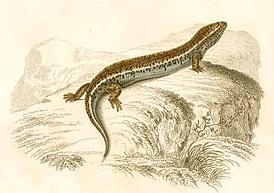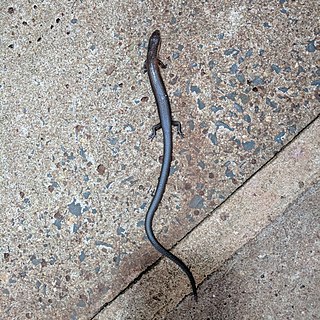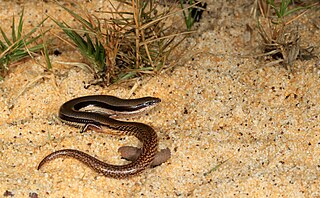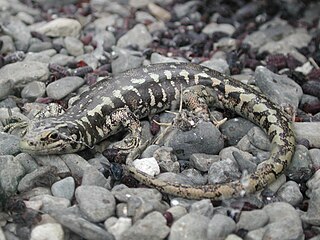
Skinks are lizards belonging to the family Scincidae, a family in the infraorder Scincomorpha. With more than 1,500 described species across 100 different taxonomic genera, the family Scincidae is one of the most diverse families of lizards. Skinks are characterized by their smaller legs in comparison to typical lizards and are found in different habitats except arctic and subarctic regions.

Carlia is a genus of skinks, commonly known as four-fingered skinks or rainbow skinks, in the subfamily Eugongylinae. Before being placed in this new subfamily, Carlia was recovered in a clade with the genera Niveoscincus, Lampropholis, and others of the Eugongylus group within Lygosominae.

Chalcides is a genus of skinks.

The earless skinks form the genus Hemiergis in the skink family Scincidae. All earless skinks are native to Australia. They are also called mulch skinks.

Leptosiaphos is a genus of skinks endemic to West Africa.

Lerista is a diverse genus of skinks endemic to Australia, commonly known as sliders.

Lygosoma is a genus of lizards, commonly known as supple skinks or writhing skinks, which are members of the family Scincidae. Lygosoma is the type genus of the subfamily Lygosominae. The common name, writhing skinks, refers to the way these stubby-legged animals move, snake-like but more slowly and more awkwardly.

The Florida sand skink is a species of lizard in the family Scincidae, the skinks. It is endemic to Florida in the United States.

Oligosoma is a genus of small to medium-sized skinks found only in New Zealand, Norfolk Island and Lord Howe Island. Oligosoma had previously been found to belong to the Eugongylus group of genera in the subfamily Lygosominae; the Australian genus Bassiana appears to be fairly closely related.

Dibamus is a genus of legless lizards in the family Dibamidae.

Anton Reichenow was a German ornithologist and herpetologist.
The Haly's tree skink is a species of lizard in the family Scincidae. The species is native to Sri Lanka. Earlier thought to be found also in the Western Ghats, taxonomic studies have shown D. haliana to be a Sri Lankan endemic, differentiated from the Indian D. subcaeruleum. D. haliana is the only arboreal skink in Sri Lanka.
Lacertaspis gemmiventris, also known as Sjostedt's five-toed skink, is a species of lizard in the family Scincidae. It is found in southwestern Cameroon and on the island of Bioko.
Lacertaspis lepesmei, also known as Angel's five-toed skink, is a species of lizard in the family Scincidae. It is endemic to the Bambouto massif, Cameroon. It is named after Pierre Lepesme, French entomologist.
Lacertaspis rohdei, also known as the Gabon lidless skink or Gaboon lidless skink, is a species of lizard in the family Scincidae. It is named after Reinhold Theodor Rohde, Australian missionary.
Leptosiaphos amieti, also known commonly as the Cameroon five-toed skink, is a species of lizard in the family Scincidae. The species is endemic to Cameroon.
Fuhn's five-toed skink is a species of lizard in the family Scincidae. The species is endemic to Cameroon.
The ghost skink is a species of skink endemic to Australia.
Ancylodactylus is a genus of diurnal (day) geckos in the family Gekkonidae. The genus is endemic to Africa. Most of the species in the genus Ancyclodactylus were formerly assigned to the genus Cnemaspis.










